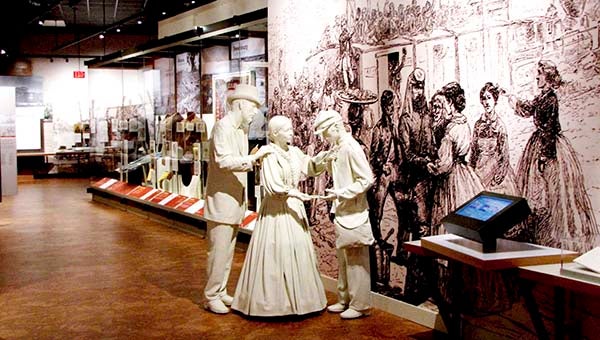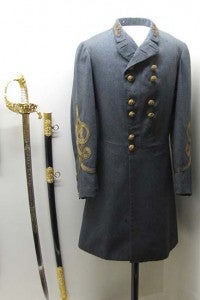Museum of the Confederacy – Appomattox offers rich displays of Civil War history
Published 11:51 am Saturday, March 8, 2014

Inside the museum are numerous photograph, artifacts, pictures and interactive displays that can inform and entertain visitors for several hours. — COURTESY | MUSEUM OF THE CONFEDERACY – APPOMATTOX
S. Waite Rawls III

Robert E. Lee’s actual sword and frock coat are on display at the Museum of the Confederacy – Appomattox. — COURTESY
| MUSEUM OF THE CONFEDERACY – APPOMATTOX
Archie Howell wrote a very good article in the Feb. 26 issue of The Tidewater News about the National Park Service site in Appomattox, where Robert E. Lee surrendered the Army of Northern Virginia to Ulysses S. Grant’s Union forces. It is one of America’s most hallowed grounds, as the Civil War effectively ended there, giving definition to the United States that we now enjoy. The magnanimous treatment shown to the Confederates by the Federals has become a model for the world to admire and emulate. The buildings on the Park Service site are 1940s recreations of the originals, much like Colonial Williamsburg, but the “sense of place” created by the buildings and grounds is truly moving.
A trip to Appomattox, however, is not complete without a visit to the Museum of the Confederacy – Appomattox, which opened to the public in March 2012 just outside the Park boundary. There, a visitor can see many of the images and artifacts of the men and women of the South and get a much more human sense of the war.
The keynote exhibit “Appomattox” leads the visitor from the beginnings of the war to beyond its end, as the South returned to the Union and the soldiers, following Robert E. Lee’s advice, went home to return to civilian life.
The Wall Street Journal reviewed the museum last year, saying, “This new outpost is so rich with artifacts, presented in such informative and interesting ways, that you may well want to plan two days here. After your first trip through the 5,000 square feet of gallery space, you’ll want to turn right around and go through again, afraid that you’ve missed something.”
It must be emphasized that there are no reproductions in this museum. It houses the “real stuff” that made history.
The main gallery develops three major themes. The first area describes the election of Lincoln, the separation of the Southern states to create the Confederacy, and the four years of war. The high point is Lee’s letter of resignation from the U.S. Army, in which he stated, “save in the defense of my native state shall I ever again draw my sword.” And his sword, the actual one he carried to meet with Grant, is in the adjoining case. It continues with a review of the major campaigns of the War, with numerous Confederate flags (including many that are far different from the flag normally associated with the Confederacy), 25 uniforms, and a number of interactive techniques that have attracted folks from those who know little about the conflict to the died-in-the-wool Civil War buff.
The second area deals with not only the Appomattox surrender, but also those of other Confederate forces, including some that most visitors have never heard about. Again, the high point concerns Robert E. Lee, as a special case contains the uniform and gloves that he wore to his meeting with Grant, along with the pen he used to sign the surrender, along with an audio of his famous farewell address to his army.
One of the interesting features is a computer on which you can possibly find an ancestor (I found several of mine) who was surrendered with Lee. If you find one, at the front desk you can order a copy of the original document that contains his name on the surrender list. A number of uniforms, swords, pistols and flags that were used at Appomattox are in a large adjoining case.
The third area answers the question of “what happened to them then?” as it traces their steps home to an exhausted and decimated South.
The clear highlight here is an interactive “wall of faces” where over a hundred photographs of soldiers and civilians, men and women, slaves and free blacks are featured — each containing a story about what they did after the war. Their accounts come tumbling home, and many visitors spend a long time examining the stories.
As a feature, throughout the whole exhibit, artifacts are accompanied by photographs and descriptions of the person who wore the uniform or carried the pistol, making the visitor’s experience more about the people and less about the statistics and dates that usually accompany history.
The adjoining gallery has a brand new exhibit on Confederate veterans. As the men grew older and began having reunions and creating associations, they assumed leadership roles in society; but they never forgot their experiences or the men who did not make it to the end. We are very familiar with today’s soldiers, who return from service in the Middle East. How did the “wounded warriors” of 150 years ago return to society and what did they do to commemorate their service?
The Museum of the Confederacy’s deep collection of these years is unmatched, and it has never previously been featured in an exhibit. We know now about the Sons of Confederate Veterans. What did their ancestors actually do and how did they remember it?
A visitor should probably plan three hours to see both the National Park and the Museum, but a trip will create the memory of a lifetime.
Note: The Museum of the Confederacy announced in November 2013 that it was combining forces with the American Civil War Center at Historic Tredegar to become The American Civil War Museum: Confederacy, Union, Freedom, creating the country’s premier Civil War museum system.
S. WAITE RAWLS III is a “Proud Franklin Bronco, Class of 1966” and co-chief executive officer of The American Civil War Museum.





